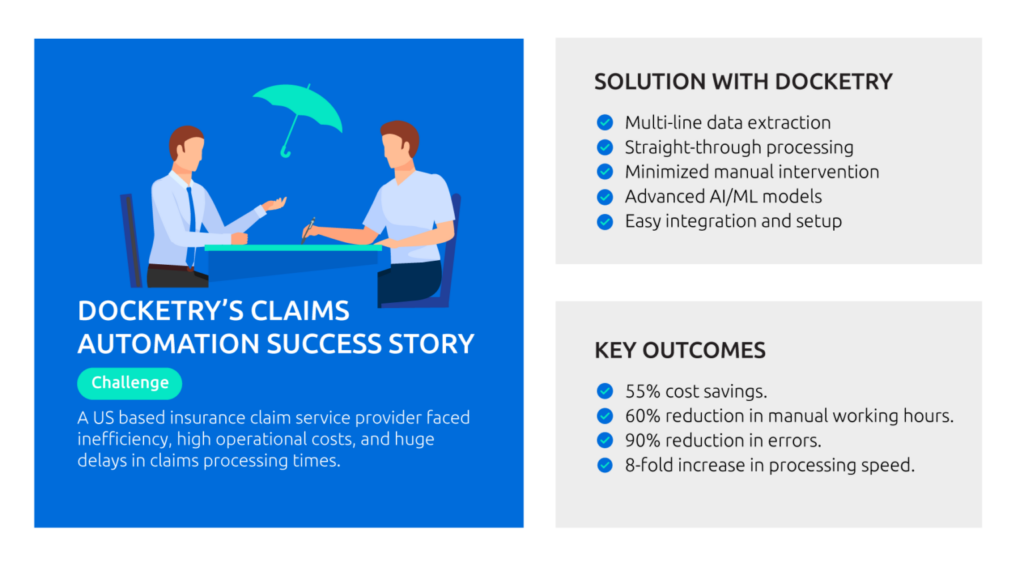
17 Aug How Claims Automation Cuts Insurance Costs
In the intricate sphere of insurance, one crucial aspect often falls under the spotlight – claims processing. It’s the moment of truth for insurance companies, where policyholders eagerly await compensation for their losses, and they are ought to deliver on their commitment. Thus, timely and efficient claims processing drives customer satisfaction, loyalty, and cost reduction.
According to Deloitte, claims processing typically accounts for around 70% of insurers’ costs. Claims processing, as you know, has historically been a complex and labor-intensive manual process. It’s a process prone to errors and fraud, ultimately affecting the efficiency of claims processing and incurring high costs for insurance companies.
According to Deloitte, claims processing typically accounts for around 70% of insurers’ costs. Claims processing, as you know, has historically been a complex and labor-intensive manual process. It’s a process prone to errors and fraud, ultimately affecting the efficiency of claims processing and incurring high costs for insurance companies.

What is claims process automation?
Claims process automation is the use of technology designed to automate the handling and processing of healthcare and insurance claims. By leveraging cutting-edge technologies like machine learning, artificial intelligence, and natural language processing, claims automation streamlines operations, reduces manual work, and significantly improves efficiency in claims processing.
The importance of efficient claims processing
Claims processing can be a slow and tedious affair. Inefficient manual processes often take days or even weeks for complex claims to be resolved. The consequences are significant: frustrated policyholders and high costs for insurance companies. Not to mention, the longer a claim remains open, the more its processing costs rise, ultimately affecting both loss and combined ratios. The volume of unstructured data involved in claims processing further compounds the issue, making manual processing prone to errors and fraud. Insurance fraud alone costs the industry billions of dollars each year.
Choosing the right data extraction solution
Selecting the right data extraction solution is a critical decision for businesses seeking to optimize their data management processes. With the vast amount of data available, it is essential to choose a solution that can efficiently extract, transform, and load data from various sources. Factors to consider include the solution’s compatibility with existing systems, scalability, ease of use, and security features. Additionally, the solution should offer advanced data cleansing and validation capabilities to ensure accurate and reliable data extraction. By carefully evaluating these factors and choosing a robust and flexible data extraction solution, businesses can streamline their operations, improve data quality, and make informed decisions based on reliable insights. A data extraction tool like Docketry can help businesses across businesses and industries to streamline their accounting processes.

How claims automation with Docketry cuts costs
Claims automation becomes the beacon of hope for the insurance industry. By implementing advanced AI technologies like Docketry insurance companies can significantly improve efficiency, reduce costs, and enhance the customer experience. Here are the ways in which claims automation helps in achieving these objectives:
Faster time to resolution
Prompt resolution of insurance claims is pivotal to customer satisfaction and cost management. Long-drawn-out claim processing leads to frustrated policyholders, potential loss of clients, and increased costs for insurance companies. Through automation the initial receipt and processing of claims documents become faster. The quicker you gather all the necessary data for a claim, the faster you can resolve it, reducing costs in the process.
Reduction of manual activity
Automating manual processes within claims submissions results in significant cost reductions and improved loss ratios. With AI handling tasks such as transcribing call centre phone calls and intelligent intake assessing damages based on photos, the need for extensive manual effort decreases, speeding up the adjudication process.
More complete claims submissions
Automation allows insurance companies to gather more data from claims documents. This extensive data collection facilitates more nuanced adjudication of claims, especially in commercial insurance. A fair and accurate assessment of claim exposure reduces costs related to loss ratios and impacts both loss and combined ratios positively.
Detection of insurance fraud
AI technologies help in identifying fraudulent claims efficiently. Technologies like intelligent intake can process and understand data and compare it to other datasets, enabling the detection of fraud. Recognizing potential indicators of fraud that might be challenging for humans to identify reduces loss ratios by flagging claims that should be denied.
Improved customer experience
By streamlining processes and reducing the need to ask customers to submit the same documents multiple times, claims automation not only cuts costs but also enhances the customer experience. Faster claims processing leads to happier policyholders and higher NPS, ultimately boosting the reputation of insurance companies.
Faster time to resolution
Prompt resolution of insurance claims is pivotal to customer satisfaction and cost management. Long-drawn-out claim processing leads to frustrated policyholders, potential loss of clients, and increased costs for insurance companies. Through automation the initial receipt and processing of claims documents become faster. The quicker you gather all the necessary data for a claim, the faster you can resolve it, reducing costs in the process.
Reduction of manual activity
Automating manual processes within claims submissions results in significant cost reductions and improved loss ratios. With AI handling tasks such as transcribing call centre phone calls and intelligent intake assessing damages based on photos, the need for extensive manual effort decreases, speeding up the adjudication process.
More complete claims submissions
Automation allows insurance companies to gather more data from claims documents. This extensive data collection facilitates more nuanced adjudication of claims, especially in commercial insurance. A fair and accurate assessment of claim exposure reduces costs related to loss ratios and impacts both loss and combined ratios positively.
Detection of insurance fraud
AI technologies help in identifying fraudulent claims efficiently. Technologies like intelligent intake can process and understand data and compare it to other datasets, enabling the detection of fraud. Recognizing potential indicators of fraud that might be challenging for humans to identify reduces loss ratios by flagging claims that should be denied.
Improved customer experience
By streamlining processes and reducing the need to ask customers to submit the same documents multiple times, claims automation not only cuts costs but also enhances the customer experience. Faster claims processing leads to happier policyholders and higher NPS, ultimately boosting the reputation of insurance companies.

The future of claims processing in the insurance industry
Claims automation is the future of the insurance industry, offering a myriad of benefits, with cost reduction being a significant driver. Automation not only streamlines the claims process but also enhances efficiency, reduces errors, and mitigates fraud. As insurance companies shift their focus to achieving higher customer satisfaction and loyalty, embracing claims automation with the right technologies becomes an imperative step in the right direction. The advanced AI solution like Docketry not only cuts costs but also paves the way for a brighter future for the entire industry.
